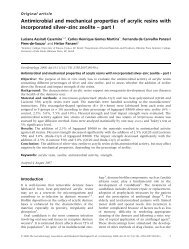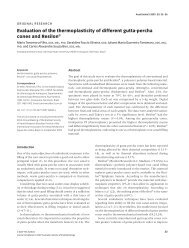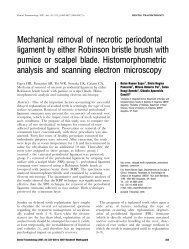Clinical evaluation of low-level laser therapy and fluoride varnish for ...
Clinical evaluation of low-level laser therapy and fluoride varnish for ...
Clinical evaluation of low-level laser therapy and fluoride varnish for ...
You also want an ePaper? Increase the reach of your titles
YUMPU automatically turns print PDFs into web optimized ePapers that Google loves.
1184<br />
S. A. M. CORONA et al.<br />
then promotes a mechanical de<strong>for</strong>mation <strong>of</strong> nerve<br />
endings at the pulp/dentine interface (odontoblastic<br />
layer <strong>and</strong> subodontoblastic extract), which is transmitted<br />
as a painful sensation. There<strong>for</strong>e, it seems<br />
appropriate to assume that any substance or technique<br />
that reduces dentinal fluid movement or dentine<br />
permeability should decrease sensitivity (Pashley,<br />
1986).<br />
Considering the mechanism <strong>of</strong> action <strong>and</strong> treatment<br />
modalities, the desensitizing agents may be assigned to<br />
three main groups: the anti-inflammatory, the therapeutic<br />
tubule occlusive agents <strong>and</strong> those with effect on<br />
the depolarization <strong>of</strong> nerve endings. The products<br />
which promote partial or total closure <strong>of</strong> dentinal<br />
tubules, such as oxalates (Wichgers & Emert, 1996; Jain<br />
et al., 1997), resin bonding agents (Wichgers & Emert,<br />
1996; Li et al., 2000), <strong>for</strong>mulations containing potassium<br />
ions (Greenhill & Pashley, 1981; Muzzin &<br />
Johnson, 1989; Martinelli & Pereira, 2000; Orchardson<br />
& Gillam, 2000; Santiago & Pereira, 2000; Fitz,<br />
Markowitz & Napolitano, 2001) <strong>and</strong> abrasive dentifrices<br />
(Kodaka et al., 2001) are the most commonly used.<br />
These agents interfere with the hydrodynamic mechanism,<br />
as they act on the exposed sensitive area so as to<br />
reduce the number <strong>of</strong> open dentinal tubules or decrease<br />
their diameter thereby minimizing the movement <strong>of</strong><br />
dentinal fluid. The direct result is the relief <strong>of</strong> painful<br />
symptomatology.<br />
Sodium <strong>fluoride</strong> (NaF) has also been indicated <strong>for</strong><br />
treating dentine hypersensitivity <strong>and</strong> it is available in a<br />
variety <strong>of</strong> <strong>for</strong>ms. The use <strong>of</strong> fluoridating <strong>varnish</strong>es with<br />
sodium <strong>fluoride</strong> (in high concentrations) as the active<br />
ingredient has been advocated to increase time <strong>of</strong> action<br />
<strong>of</strong> NaF in contact with exposed dentin, thus aiming to<br />
enhance its effectiveness in decreasing dentine sensitivity<br />
(Gaffar, 1999; Lan, Liu & Lin, 1999). However, the<br />
attempt to provide tubule closure or narrowing is<br />
relatively short-lived because the <strong>varnish</strong> has a gradual<br />
therapeutic action (progressive in time) <strong>and</strong> can be<br />
removed during tooth brushing, be<strong>for</strong>e its desensitizing<br />
effect may be achieved (Lan et al., 1999).<br />
The advent <strong>of</strong> dental <strong>laser</strong>s has raised another<br />
possible treatment option <strong>for</strong> dentinal hypersensitivity<br />
<strong>and</strong> has become a research interest in the last decades.<br />
The <strong>laser</strong>s used <strong>for</strong> the treatment <strong>of</strong> sensitive teeth may<br />
be divided in to two groups. The middle output power<br />
<strong>laser</strong>s – Nd:YAG <strong>and</strong> CO 2 <strong>laser</strong>s <strong>and</strong> the <strong>low</strong>-<strong>level</strong> <strong>laser</strong>s<br />
– helium-neon (He–Ne) <strong>and</strong> gallium–aluminum–arsenide<br />
(GaAlAs) (diode) <strong>laser</strong>s.<br />
The <strong>low</strong>-<strong>level</strong> or ‘s<strong>of</strong>t’ <strong>laser</strong>s provide cold thermal <strong>low</strong><br />
energy wavelengths with little temperature increase <strong>of</strong><br />






